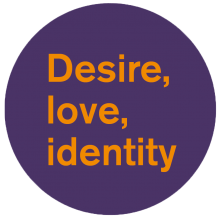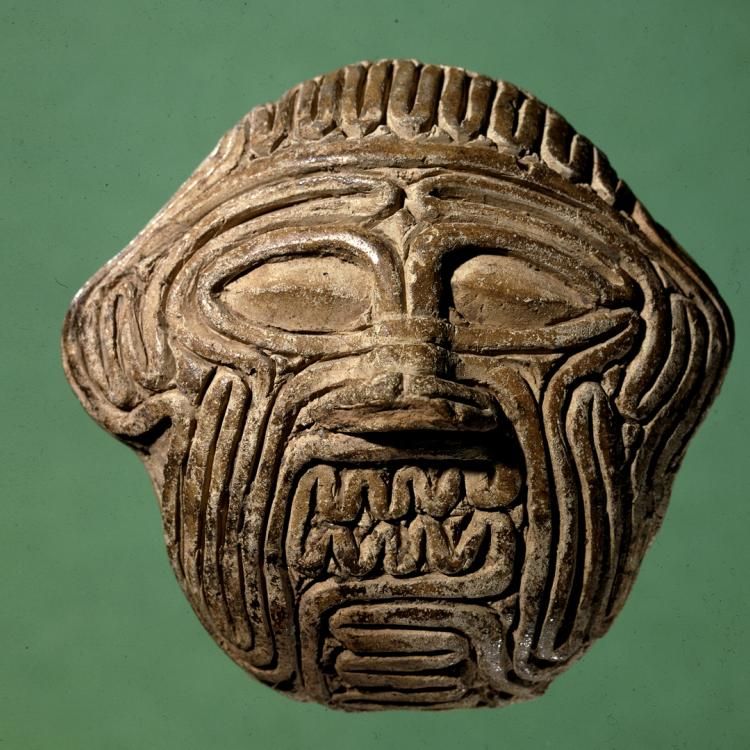To help you on your trail
Follow this logo to find the objects

Choose a trail looking at objects that have a connection with LGBTQ history.
Fifteen-object trail – you should be able to complete this trail in 60–75 minutes. The objects have been arranged to create an efficient route. However, you don't need to follow this order.
Three-object trail – this trail is ideal if you only have 30 minutes to spare.
Audio commentaries – you can download audio commentaries for each of the objects on both trails to listen to on your own device. Search for 'Desire, love, identity' in Apple Music, YouTube Music or Spotify. A transcript of the object trail is also available.
The Museum regularly lends objects to other institutions around the world. This means that from time to time, some of the objects that are part of the trail may be temporarily removed from display.
Fifteen-object trail
1. The Discus Thrower (Room 1)
This sculpture may have been part of a larger group of statuary (collection of statues/sculptures). The beautiful youth Hyacinth was struck and killed by a discus thrown by his lover, the god Apollo. The discus was blown off course by the jealous Zephyr.
Maori treasure box
2. Maori treasure box (Room 1)
This intricately carved wooden box features male and female figures intertwined in sexual union. One scene appears to blur heterosexual boundaries and gender roles.
Statue of Ganymede
3. Statue of Ganymede (Room 1)
In mythology, the god Zeus (or Jupiter) was overcome by desire for the beautiful youth Ganymede. He took the form of an eagle to abduct Ganymede who later became the god's cupbearer.
A Maya ruler
4. A Maya ruler (East stairs)
This image of a male Maya ruler was once assumed to be a woman. He's dressed as a youthful maize deity who combines male and female genders.
N'domo masquerade mask
5. N'domo masquerade mask (Room 25)
In many African cultures, gender and gendered roles are fixed through rituals. N'domo masks are worn by men but the masks can be male, female or androgynous.
Queen of the Night
6. Queen of the Night (Room 56)
The Mesopotamian deity Ishtar had the power to assign gender. Some of her cult members seem to have been considered woman-like men who did forbidden things to delight her.
Please note this object is currently part of a touring exhibition and will not be on display until 2025. Several small terracotta figures depicting Ishtar are on display in the case that usually houses the Queen of the Night.
Epic of Gilgamesh
7. Epic of Gilgamesh (Room 56)
This famous poem describes how King Gilgamesh and the Wildman Enkidu became close friends. The text describes their relationship in erotic terms. The two men have various heroic adventures, including killing a demon called Humbaba.
Hor and Suty
8. Hor and Suty (Room 61)
This inscribed stela (stone tablet) is dedicated to two ancient Egyptian men, Hor and Suty. Is it possible that they may have been lovers, or were they twins?
The Warren Cup
9. The Warren Cup (Room 70)
Decorated with two scenes of male lovers, this Roman wine cup could not be displayed publicly for most of the 20th century. Homosexuality was illegal in England and Wales until July 1967.
Hadrian and Antinous
10. Hadrian and Antinous (Room 70)
The beautiful youth Antinous was the emperor Hadrian’s lover. When Antinous drowned in AD 130, Hadrian made him into a god and publicly commemorated him across the empire.
Athenian wine amphora
11. Athenian wine amphora (Room 69)
Intimate sexual relationships between men and youths were an accepted part of life in several ancient Greek city states, particularly in Athens during the 6–4th century BC.
Sappho
12. Sappho (Room 69)
Although little is known for certain about the Greek poet Sappho's life, her poems gave a voice to female desire that still resonates today.
Saint Sebastian
13. Saint Sebastian (Room 40)
In recent times Saint Sebastian has become a gay icon inspiring filmmakers, writers and artists. The imagery of him which has become so influential originated in medieval Europe.
Ladies of Llangollen
14. Ladies of Llangollen (Room 47)
Lady Eleanor Butler and Sarah Ponsonby fled Ireland together in 1778. They set up home in North Wales, challenging the conventions of the era and living the life of their choice there for 50 years.
The Ain Sakhri Lovers
15. The Ain Sakhri Lovers (Room 51)
This object dates from about 11,000 years ago. It's the oldest known sculpture of two lovers. The genders of the figures are unclear and open to interpretation. All that remains is the reflection of their love.
Hadrian and Antinous
1. Hadrian and Antinous (Room 70)
The beautiful youth Antinous was the emperor Hadrian's lover. When Antinous drowned in AD 130, Hadrian made him into a god and publicly commemorated him across the empire.
Queen of the Night
2. Queen of the Night (Room 56)
The Mesopotamian deity Ishtar had the power to assign gender. Some of her cult members seem to have been considered woman-like men who did forbidden things to delight her.
Please note this object is currently part of a touring exhibition and will not be on display until 2025. Several small terracotta figures depicting Ishtar are on display in the case that usually houses the Queen of the Night.
Ladies of Llangollen
3. Ladies of Llangollen (Room 47)
Lady Eleanor Butler and Sarah Ponsonby fled Ireland together in 1778. They set up home in North Wales, challenging the conventions of the era and living the life of their choice there for 50 years.
Find out more
The Museum's Prints and drawings department holds many works on paper with an LGBTQ connection. You can explore the Collection online or make an appointment to view works in the Prints and Drawings study room.
Visit Google Arts to find out more about the objects in this trail and LGBTQ histories in the British Museum collection.
RB Parkinson's A Little Gay History: Desire and Diversity across the World (British Museum Press, 2013) focuses on 40 objects in the British Museum collection, including most of those featured in this trail.
The following books provide more information about individual objects.
- Dyfri Williams, The Warren Cup (British Museum Press, 2006)
- Ian Jenkins, The Discobolus (British Museum Press, 2012)
- Dominique Collon, The Queen of the Night (British Museum Press, 2005)





